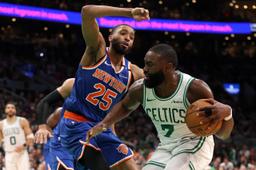Playoff games are decided in countless ways—second-chance opportunities, transition defense, free throws, live-ball turnovers, timely help rotations, off-ball brain farts, and approximately one million other variables—between two teams that scrape and claw to dominate as many margins as they possibly can.
But after a thrilling series opener between the Boston Celtics and New York Knicks on Monday, it’s hard not to stare at the stat sheet and chalk up the final score to some of the worst 3-point luck in NBA history.
New York won in overtime, 108-105. With steely shotmaking (the Knicks finished 17-for-37 behind the arc and were a lights-out 7-for-14 in the fourth quarter and overtime), several timely offensive rebounds, and a general relentlessness within 142 combined minutes from Josh Hart, Mikal Bridges, and OG Anunoby, they tempered a 20-point second-half deficit and didn’t fold. Road wins in the playoffs are hard. The Knicks earned their fourth of the young postseason.
Meanwhile, Boston helped, launching 60 3s and missing 45 of them—both of which are NBA postseason records. Some of those attempts were curious decisions, rushed, off-balance, or launched haphazardly during a period of the game when the Celtics held a sizable lead—it climbed up to 20 in the third quarter—and they often looked like they were playing with their food. Jayson Tatum, who finished 4-for-15 from deep, capped off his frustrating night when he got Mitchell Robinson in a switch and decided to hoist a stepback 3 with 5.5 seconds left in regulation—even though the paint was wide open and New York’s help defense was a step slow for most of the night.
But Boston, a team that entered the playoffs with an astronomical plus-402 3-point differential, also generated plenty of wide-open looks it just flat-out missed. The defending champs spent most of Game 1 picking the Knicks (a team they swept during the regular season) apart, to the point where it was difficult to gauge exactly what Tom Thibodeau and his coaching staff were even telling their team to do. Much of this was because Jalen Brunson and Karl-Anthony Towns—two All-Stars who double as New York’s weakest links—were getting poked at over and over and over again, yielding to a Celtics offense that pretty much took whatever it wanted when either one was targeted in a pick-and-roll. Boston intentionally ran staggers that engaged both at the same time, and, short of crossing its fingers and hoping for a miss, there was little New York could do to consistently slow Boston down:
Every possession tells a story, and in Game 1, so many of them had The Knicks really can’t do anything to stop this offense tattooed across their forehead. But for at least one night, it didn’t matter. According to Sportradar, Boston generated just 0.84 points per possession on the 25 plays that ended with an unguarded catch-and-shoot jumper. That volume is exceptional and must’ve felt like a breath of fresh air for the Celtics, who are probably thrilled to no longer be competing against the feisty Orlando Magic. The results, though, are heinous. (During the regular season, Boston made 1.18 points per shot on all its catch-and-shoot jumpers, which was fourth best in the league.)
Giving up home court and being down 0-1 is less than ideal, but the Celtics should feel more hopeful about what the film shows them than the Knicks. “To me, I look at the process and the shot quality. So our shot quality was high. The points in the paint were even. We shot one more layup than they did. We shot 10 non-paint 2s, and they shot much more than that,” Celtics head coach Joe Mazzulla said. “At the end of the day, you have to make the ones when you’re open. And you have to trust the process of what you do, and the process of our shot quality was good.”
The Celtics were able to easily exploit Thibodeau’s decision to switch every defender except Brunson at the point of attack. That included Towns, who, instead of dropping, almost exclusively switched on the perimeter, even when the Celtics forced him to navigate a second ball screen. (During the regular season, no other team switched less often than New York.) It was awkward and clunky and, by and large, didn’t work. But for the Knicks defense, which is highly leveraged and desperate to limit Boston’s 3-point volume, it also kind of made sense.
Thibs studied Orlando’s Round 1 game plan and clearly liked the idea of keeping his defense out of rotation as much as possible. Switching nearly across the board not only limits Boston’s drive-and-kick attack but also induces isolation basketball and puts individual defenders in position to battle Tatum and Jaylen Brown inside the arc. Thibs didn’t want New York helping off of shooters or losing track of Celtics who might sneak in for an offensive rebound. He kept things relatively simple to accomplish that goal. The results were a mixed bag:
This is a tough strategy to stay disciplined with, particularly if you’re the Knicks, who need Towns and Brunson to stay fresh and out of foul trouble. Asking either to consistently switch or to hedge and recover without too much help behind the play is a recipe for death, particularly against Boston. Eventually, the stress of it all broke New York’s brain. Here’s Brown hunting Brunson, rejecting the screen, and forcing help; then, at the last second, with Tatum lurking in the weakside corner, Anunoby decides to leave Luke Kornet wide open in the paint at the worst possible time:
What’s funny about this is that New York can do only so much with a scheme that its personnel isn’t built to execute, against an offense that is built to exploit mismatches. As the game went on, it became less and less clear what the Knicks even wanted to do. Thibodeau is known for his refusal to make any night-to-night adjustments in the playoffs until he’s satisfied that his team is doing a good enough job executing the initial strategy. If that holds true, there’s a good chance the Knicks will do much of the same in Game 2. Or, at least, try their best.
Again, the Celtics were still able to generate the most 3s we’ve ever seen in an NBA playoff game. They ripped the Knicks’ game plan to shreds. Here’s Tatum getting Towns in a switch, driving by him, and finding Jrue Holiday on a roll. And then, after Mikal Bridges collapses the paint for some reason, Holiday kicks it out to Derrick White for the open 3:
The Celtics ran Brunson ragged, and by the end of the game they knew that he absolutely did not want to switch any screens. Here, the Celtics know that the hedge is coming, Holiday sets a great screen on Towns, and Tatum just misses the shot:
This action also led to a bucket several times. And unless Brunson is able to grow 6 inches and gain 50 pounds between now and the moment this series ends, whoever he’s guarding will continue to go at him. There’s no hiding against the Celtics. Brunson will have a bull’s-eye on his back as long as he’s facing them, whether it’s Payton Pritchard or Sam Hauser, let alone White or Holiday.
Historic anomalies happen. The Knicks don’t have to put an asterisk next to this victory, and they should pop the smallest bottle of Champagne in their minibar after stealing a road game in a series everyone expects them to lose. Anunoby took advantage of every chance Boston gave him, and Josh Hart headbutted his way into several opportunities that Boston definitely did not want to give him, whether on the offensive glass or in transition.
Brunson’s two pull-up 3s near the end of the fourth quarter (after getting Al Horford on a switch) were massive, and the mental mistakes Brown has made helping off the corners throughout his career came back to bite him more than once in Game 1. Three-point variance never tells the entire story of a final score. But a team’s process can be more sustainable than one result this early in a seven-game series. And even in a nightmarish defeat, Boston still looked like the superior team.



